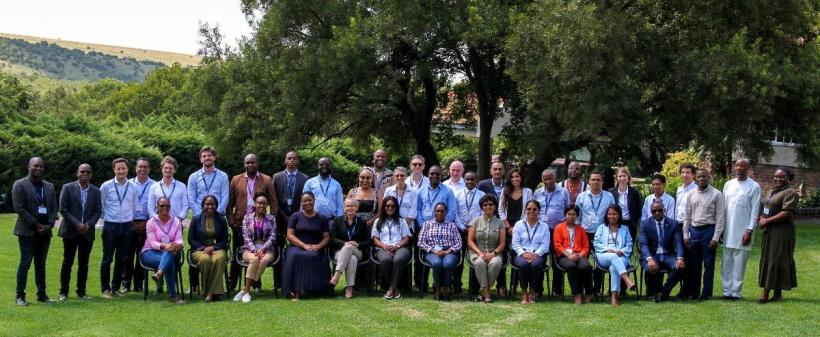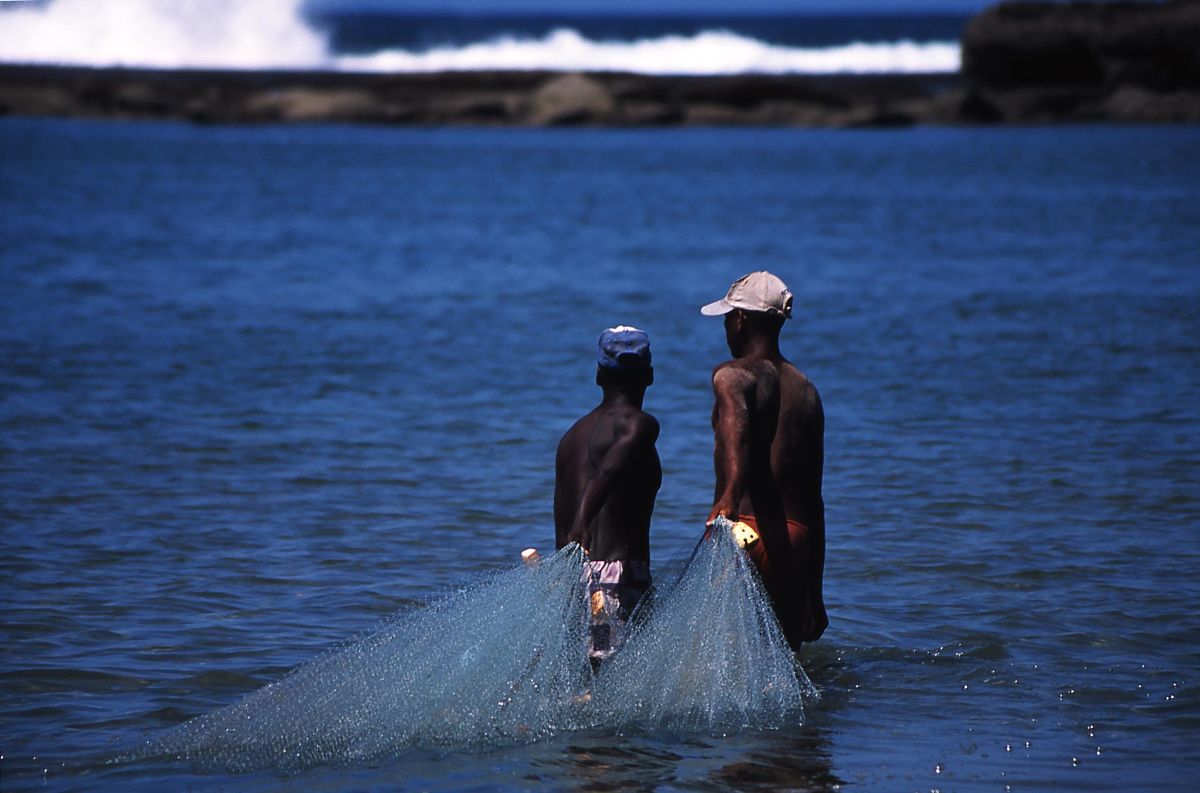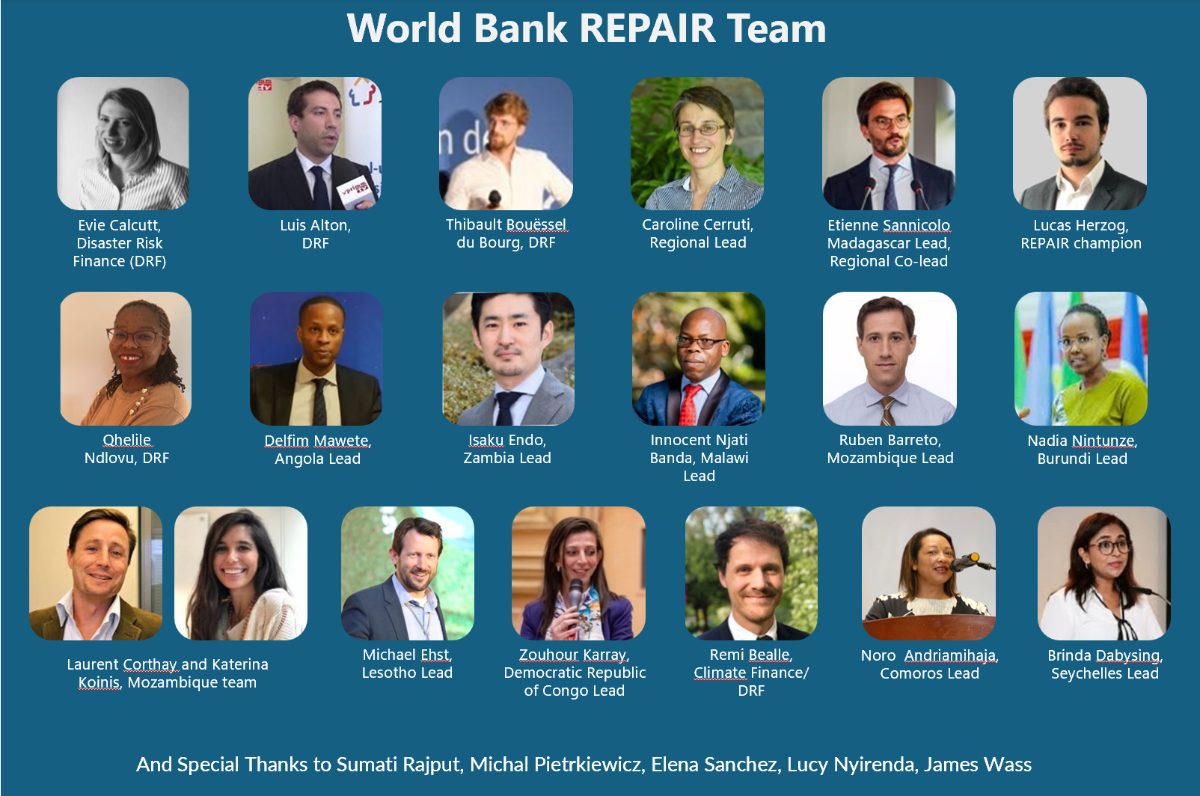REPAIRing from Shocks and Building Resilience: Transforming Disaster Risk Finance in Southern Africa

REPAIR team members at a workshop
The Regional Emergency Preparedness and Access to Inclusive Recovery Program (REPAIR) is the culmination of over a decade of hands-on experience and deep commitment to disaster risk finance (DRF) in Southern Africa. What began as a simple idea sketched out on a piece of paper has now grown into a transformative and impactful program. As we speak with some of the members of the team behind the initiative, it becomes clear that the program, which is being launched in the second half of 2024, isn’t just a technical solution—it is a holistic program shaped by the real challenges and aspirations of the countries in the region. “These countries already understood tools like parametric insurance and reserve funds,” shares Caroline Cerruti (Lead Financial Sector Specialist, World Bank Group [WBG]), “but they needed something more comprehensive to handle the shocks that fall in between. This need for a more holistic, layered approach inspired the establishment of REPAIR.”
Over six million people in Comoros, Madagascar, and Mozambique are set to benefit from REPAIR, which was approved by the WBG board in July 2024. The program, which will be implemented by the African Risk Capacity Limited (ARC Ltd), will strengthen countries’ resilience against climate shocks and seek to attract $205 million in private capital to support these efforts in its first phase. The WBG’s Global Shield Financing Facility (GSFF) has endorsed the REPAIR work plan with a US$30 million grant to support the establishment of a new regional climate fund that will eventually encompass 12 countries in Southern Africa.
In this interview of the “In the Spotlight” series, we speak to Caroline Cerruti, Etienne Sannicolo (Senior Financial Sector Specialist, WBG), and Avinash Ramessur (Senior Programme Manager REPAIR, African Risk Capacity Limited), and delve into how REPAIR is closing the financial protection gaps, building resilience from the ground up, and paving the way for broader regional collaboration.
Boosting Financial Preparedness to Respond to Climate Shocks in Africa: A video on REPAIR
What are the core objectives of REPAIR?
Caroline Cerruti: Over the past 10 years, we’ve conducted disaster response diagnostics, developed strategies, and provided technical assistance to almost all the countries in Southern Africa. We observed that, while countries were familiar with various DRF tools, these instruments weren't enough to handle every type of shock. REPAIR allows countries to respond to small, medium, and large-scale shocks by offering a layered approach: a reserve layer for small shocks, contingent financing for medium shocks, and parametric insurance for catastrophic events.
What is the vision for REPAIR?
Caroline Cerruti: REPAIR is built on three key principles: speed, flexibility, and sustainability. Funds will be disbursed within seven days of a shock, and countries can choose the best way to deploy them depending on the situation. The program is designed as a sustainable platform that can attract additional financing for disaster response. These principles—along with inclusivity—are at the core of REPAIR’s long-term vision. We envision REPAIR as an Africa-wide platform; eventually, it will become a continent-wide solution that leverages economies of scale to reduce the cost of financial instruments.

REPAIR goes beyond insurance in financial preparedness. Can you tell us more?
Caroline Cerruti: We noticed that some governments have structured their insurance policies to ensure frequent payouts, but this leads to high premiums or limited coverage. REPAIR aims to complement insurance with reserve funds and contingent financing so that insurance focuses on catastrophic events which have a lower probability of occurring. This way, countries can maintain affordable premiums and improve their overall coverage when a disaster does strike. Additionally, REPAIR links financing to pre-identified delivery channels—like social protection systems—ensuring that funds quickly reach the people who need them most when a disaster occurs.
What does REPAIR mean in terms of combining financial and operational preparedness?
Etienne Sannicolo: The program’s strength lies in linking financial preparedness with operational readiness. In Madagascar, the government had a catastrophe deferred drawdown option and parametric insurance, but the funds remained stuck in the Ministry of Finance due to a lack of pre-arranged delivery channels. We are working to ensure that funds can flow quickly through these channels, allowing for a more efficient emergency response. Additionally, we’re exploring innovative solutions like using blockchain technology to make the flow of funds more transparent.

How does REPAIR support micro, small, and medium enterprises (MSMEs)?
Etienne Sannicolo: We’ve noted that, very often, small and medium firms, which account for the greatest number of jobs, are forgotten from disaster response. The program aims to create permanent mechanisms that give MSMEs quick and cheap access to liquidity during climate shocks. In Madagascar, we’re working to create a new window in the existing Partial Portfolio Credit Guarantee Fund, enabling financial institutions to offer affordable loans to MSMEs affected by disasters. This will help preserve jobs and speed up economic recovery in impacted regions.
What role do development partners and the private sector play in strengthening financial resilience through REPAIR?
Etienne Sannicolo: REPAIR is a platform designed to coordinate the efforts of various donors and partners. When a disaster strikes, multiple actors are ready to help, but without a coordinated approach, the response can be inefficient. REPAIR aims to empower Ministries of Finance to coordinate with other donors such as the Global Shield against Climate Risks, African Development Bank, World Food Programme, International Monetary Fund, and even replica insurance initiatives—to easily support governments during disasters. On the private sector side, engaging financial institutions early on is critical, especially when it comes to supporting MSMEs. We’ve held workshops with the private sector to ensure they are prepared to step in when needed.

What does REPAIR mean for African Risk Capacity Limited (ARC Ltd)?
Avinash Ramessur: REPAIR is perfectly aligned with ARC Ltd’s mission to provide disaster risk finance across Africa. Insurance is a key part of what we offer, but it cannot cover every disaster. REPAIR allows us to offer a more comprehensive solution by combining insurance with other financial tools. There’s already significant interest from West and Central African countries in adopting similar mechanisms, and we see REPAIR as a cornerstone in expanding ARC Ltd’s reach across the continent.
What excites you most about REPAIR as it moves from planning to implementation?
Avinash Ramessur: On a personal level, it’s fulfilling to work on a project with such a clear purpose—saving lives and improving resilience. Governments tend to work in silos, but REPAIR breaks down these barriers and promotes a more coordinated approach to disaster financing and response. This is a game changer, and strong governance framework in-country ensures that everyone is on the same page.
What challenges do you foresee in REPAIR’s implementation?
Caroline Cerruti: One big challenge is managing the growing interest from other countries, balancing the program’s expansion while maintaining the depth of engagement needed to strengthen country systems.
Etienne Sannicolo: Another challenge is that while REPAIR aims to transfer the residual risk caused by disasters it cannot eliminate it, so it has to be complemented by programs in-country to reduce risks and build resilience.

Please tell us a little about the team behind REPAIR.
Etienne Sannicolo: We have an incredible team, with 15 to 20 highly skilled and motivated individuals. The diversity of expertise everyone brings to the table, from technical experts to those with deep regional knowledge, is so rewarding.
Avinash Ramessur: From ARC Ltd’s perspective, we’ve worked seamlessly as one unified team with the WBG. We’ve also brought in partners and service providers who are equally passionate. It’s been a privilege to be part of such a dedicated team.
Caroline Cerruti: I couldn’t agree more. The synergy between the global and regional teams has been incredible. As we move forward, our challenge will be maintaining the technical expertise and depth we’ve established, especially as new fragile countries with no experience of climate risk insurance, like the Democratic Republic of Congo and Burundi, join the platform. It’s also about continuing our close collaboration with ARC Ltd and implementing effective peer-to-peer learning between countries.
Any final thoughts as we wrap up?
Etienne Sannicolo: REPAIR is not only about responding to climate change impacts but also about promoting climate justice. Many of the countries we’re targeting are the most affected by climate change but are the least responsible for it. Through REPAIR, we aim to raise as much funding as possible to support these countries and help rebalance the global impact of climate change.
* The REPAIR project is supported by the Global Shield Financing Facility.

